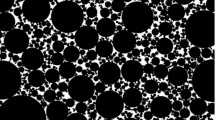Abstract
We describe a novel spatial-temporal algorithm for generating packing structures of disks and spheres, which not only incorporates all the attractive features of existing algorithms but is also more flexible in defining spatial interactions and other control parameters. The advantage of this approach lies in the ability of marks to exploit to best advantage the space available to them by changing their size in response to the interaction pressure of their neighbours. Allowing particles to move in response to such pressure results in high-intensity packing. Indeed, since particles may temporarily overlap, even under hard-packing scenarios, they possess a greater potential for rearranging themselves, and thereby creating even higher packing intensities than exist under other strategies. Non-overlapping pattern structures are achieved simply by allowing the process to ‘burn-out’ at the end of its development period. A variety of different growth-interaction regimes are explored, both symmetric and asymmetric, and the convergence issues that they raise are examined. We conjecture that not only may this algorithm be easily generalised to cover a large variety of situations across a wide range of disciplines, but that appropriately targeted generalisations may well include established packing algorithms as special cases.
Similar content being viewed by others
Explore related subjects
Discover the latest articles, news and stories from top researchers in related subjects.References
Andersson, J., Häggström, O., Månsson, M.: The volume fraction of a non-overlapping germ-grain model. Electron. Commun. Probab. 11, 78–88 (2006)
Bezrukov, A., Bargiel, M., Stoyan, D.: Statistical analysis of simulated random packings of spheres. Part. Part. Syst. Charact. 19, 111–118 (2002)
Comas, C., Mateu, J.: On soft and hard particle motions for stochastic marked point processes. J. Stat. Comput. Simul. 77, 1091–1121 (2008)
Cotar, C., Volkov, S.: A note on the lilypond model. Adv. Appl. Probab. 36, 325–339 (2004)
Daley, D.J., Mallows, C.L., Shepp, L.A.: A one-dimensional Poisson growth model with non-overlapping intervals. Stoch. Process. Appl. 90, 223–241 (2000)
Döge, G., Mecke, K., Møller, J., Stoyan, D., Waagepetersen, R.: Grand canonical simulations of hard-disk systems by simulated tempering. Int. J. Mod. Phys. 15, 129–147 (2004)
Gerrard, D.J.: (1969) Competition quotient—a new measure of competition affecting individual forest trees. Michigan State University Agricultural Experimental Station Research Bulletin, 20
Häggeström, O., Meester, R.: Nearest neighbour and hard sphere models in continuum percolation. Random Struct. Algorithms 9, 295–315 (1996)
Hansen, J.-P., McDonald, I.R.: Theory of Simple Liquids. Academic Press, London (1986)
Hermann, H., Elsner, A., Hecker, M., Stoyan, D.: Computer simulated dense-random packing models as approach to the structure of porous low-k dielectrics. Microelectron. Eng. 81, 535–543 (2005)
Kadashevich, I., Schneider, H.-J., Stoyan, D.: Statistical modeling of the geometrical structure of the system of artificial air pores in autoclaved aerated concrete. Cem. Concrete Res. 35, 1495–1502 (2005)
Lochmann, K., Oger, L., Stoyan, D.: Statistical analysis of random sphere packings with variable radius distribution. Solid State Sci. 8, 1397–1413 (2006)
Löwen, H.: Fun with hard spheres. In: Mecke, K.R., Stoyan, D. (eds.) Statistical Physics and Spatial Statistics. Lecture Notes in Physics, vol. 554, pp. 215–331. Springer, Berlin (2000)
Mościński, J., Bargiel, M.: C. Language program for the irregular close packing of hard spheres. Comput. Phys. Commun. 64, 183–192 (1991)
Penttinen, A., Stoyan, D., Henttonen, H.M.: Marked point processes in forest statistics. For. Sci. 38, 806–824 (1992)
Renshaw, E.: Birth, death and migration processes. Biometrika 59, 49–60 (1972)
Renshaw, E.: The spatial distribution of Tribolium confusum. J. Appl. Probab. 17, 895–911 (1980)
Renshaw, E.: Modelling Biological Populations in Space and Time. Cambridge University Press, Cambridge (1991)
Renshaw, E.: Two-dimensional spectral analysis for marked point processes. Biom. J. 44, 718–745 (2002)
Renshaw, E.: Stochastic Population Processes (in draft) (2010)
Renshaw, E., Särkkä, A.: Gibbs point processes for studying the development of spatial-temporal stochastic processes. Comput. Stat. Data Anal. 36, 85–105 (2001)
Renshaw, E., Phayre, S., Jakeman, E.: The development of space-time interaction processes with given spectral structure. Inverse Probl. 16, 877–890 (2000)
Renshaw, E., Comas, C., Mateu, J.: Analysis of forest thinning strategies through the development of space-time growth-interaction simulation models. J. Stoch. Environ. Res. Risk Assess. (2009, to appear)
Renshaw, E., Mateu, J., Saura, F.: Disentangling mark/point interaction in marked-point processes. Comput. Stat. Data Anal. 51, 3123–3144 (2007)
Särkkä, A., Renshaw, E.: The analysis of marked point patterns evolving through space and time. Comput. Stat. Data Anal. 51, 1698–1718 (2006)
Staebler, G.R.: Growth and spacing in an even-aged stand of Douglas fir. Master’s thesis, University of Michigan (1951)
Stoyan, D.: Hard problems with random systems of hard particles. In: Proceedings of the 54th Session of the International Statistical Institute, Berlin (2003)
Stoyan, D., Schlather, M.: Random sequential adsorption: relationship to dead leaves and characterization of variability. J. Stat. Phys. 100, 969–979 (2000)
Stoyan, D., Kendall, W.S., Mecke, J.: Stochastic Geometry and its Applications, 2nd edn. Wiley, Chichester (1995)
Torquato, S.: Random Heterogeneous Materials: Microstructure and Macroscopic Properties, 2nd ed. Springer, New York (2005)
Author information
Authors and Affiliations
Corresponding author
Rights and permissions
About this article
Cite this article
Renshaw, E., Comas, C. Space-time generation of high intensity patterns using growth-interaction processes. Stat Comput 19, 423 (2009). https://doi.org/10.1007/s11222-008-9102-y
Received:
Accepted:
Published:
DOI: https://doi.org/10.1007/s11222-008-9102-y




